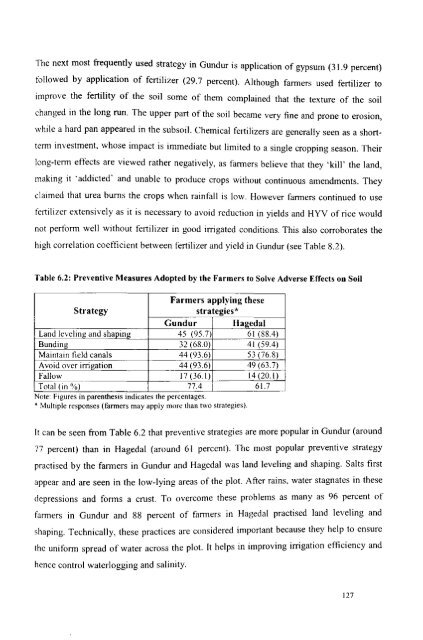Water Users Association and Irrigation Management - Institute for ...
Water Users Association and Irrigation Management - Institute for ...
Water Users Association and Irrigation Management - Institute for ...
Create successful ePaper yourself
Turn your PDF publications into a flip-book with our unique Google optimized e-Paper software.
The next most frequently used strategy in Gundur is application of gypsum (31.9 percent)<br />
followed by application of fertilizer (29.7 percent). Although farmers used fertilizer to<br />
improve the fertility of the soil some of them complained that the texture of the soil<br />
changed in the long run. The upper part of the soil became very fine <strong>and</strong> prone to erosion,<br />
while a hard pan appeared in the subsoil. Chemical fertilizers are generally seen as a shortterm<br />
investment, whose impact is immediate but limited to a single cropping season. Their<br />
long-term effects are viewed rather negatively, as farmers believe that they 'kill' the l<strong>and</strong>,<br />
making it 'addicted' <strong>and</strong> unable to produce crops without continuous amendments. They<br />
claimed that urea bums the crops when rainfall is low. However farmers continued to use<br />
fertilizer extensively as it is necessary to avoid reduction in yields <strong>and</strong> HYV of rice would<br />
not per<strong>for</strong>m well without fertilizer in good irrigated conditions. This also corroborates the<br />
high correlation coetlicient between fertilizer <strong>and</strong> yield in Gundur (see Table 8.2).<br />
Table 6.2: Preventive Measures Adopted by the Farmers to Solve Adverse Effects on Soil<br />
Farmers applying these<br />
Strategy<br />
strategies*<br />
Gundur Hagedal<br />
L<strong>and</strong> leveling <strong>and</strong> shaping 45 (95.7) 61 (88.4)<br />
Bunding 32 (68.0) 41 (59.4)<br />
Maintain tield canals 44 (93.6) 53 (76.8)<br />
Avoid over irrigation 44 (93.6) 49(63.7)<br />
Fallow 17 (36.1) 14(20.1)<br />
Total (in %) 77.4 61.7<br />
..<br />
Note: FIgures m parentheSIS mdlcates the percentages.<br />
* Multiple responses (farmers may apply more than two strategies).<br />
It can be seen from Table 6.2 that preventive strategies are more popular in Gundur (around<br />
77 percent) than in Hagedal (around 61 percent). The most popular preventive strategy<br />
practised by the farmers in Gundur <strong>and</strong> Hagedal was l<strong>and</strong> leveling <strong>and</strong> shaping. Salts first<br />
appear <strong>and</strong> are seen in the low-lying areas of the plot. After rains, water stagnates in these<br />
depressions <strong>and</strong> <strong>for</strong>ms a crust. To overcome these problems as many as 96 percent of<br />
farmers in Gundur <strong>and</strong> 88 percent of farmers in Hagedal practised l<strong>and</strong> leveling <strong>and</strong><br />
shaping. Technically, these practices are considered important because they help to ensure<br />
the uni<strong>for</strong>m spread of water across the plot. It helps in improving irrigation efficiency <strong>and</strong><br />
hence control waterlogging <strong>and</strong> salinity.<br />
127
















